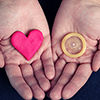I'm prone to yeast infections and get them frequently. If you've had a yeast infection, you know how miserable it can be, and how difficult it can be to go about your daily life while struggling with one. If you've never had one, maybe you don't think about it much, or maybe you live in fear of the day when you might finally experience it. Either way, here's what you need to know if you think you might have a yeast infection, or if you want to know more about how to prevent or treat one.
Note: While I have a fair amount of experience with yeast infections, I am not a doctor. Always use your own judgement when making decisions that could impact your health, and consult a doctor if you have any questions.

First, what IS a yeast infection?
Yeast is a microscopic single celled fungus. Most yeast infections are caused by a species of yeast called Candida albicans. You normally have a small amount of yeast in your vagina, but it is kept in check by naturally occurring vaginal bacteria flora. If something throws off the balance of your vaginal system or kills off your bacterial flora, the yeast can run rampant and grow into an infection. Yeast infections are frustrating and uncomfortable, but they're common, and very treatable. Most women will experience a yeast infection at some point in their life. If you think you might have one, don't panic. But do address it right away, because the longer you wait to treat it, the more uncomfortable it might become.
What causes a yeast infection?
Yeast feeds on sugars, so getting something sweet or sugary on your genitals, or eating excessive quantities of sugar, can trigger a yeast infection. Because yeast thrives in warm and moist environments, excessive moisture in your vaginal area can also lead to a yeast infection. Antibiotics are another common culprit. Since bacteria is crucial for keeping your vaginal yeast in balance, taking antibiotics can lead to a yeast infection as well. Certain chronic health problems can also increase your chances of getting a yeast infection, including diabetes and HIV/AIDS. Yeast infections are not considered an STI, but if you have an active yeast infection, it is possible to spread it to sexual partners. For some women, sex itself can trigger a yeast infection by throwing off the natural balance of your vagina. Certain birth control methods, feminine hygiene products, personal lubricants, or condoms may also trigger yeast infections or make you more susceptible to them.

Preventing Yeast Infections
One important way to help prevent yeast infections is to allow your vaginal area to breathe by wearing cotton underwear. If your clothing becomes damp or sweaty, change as soon as you can, and don't sit around in a wet bathing suit. If you wear menstrual pads or panty liners, change them frequently. Women who are prone to yeast infections may want to consider switching to tampons or menstrual cups, or washable cotton fabric pads which are typically more breathable.
It's also a good idea to avoid eating excessive quantities of sugar, especially if you're taking antibiotics. Don't use food on your genitals during sex, and avoid personal products (such as lubricants) that contain sweeteners, perfumes, or other possible irritants. Don't use feminine washes or cleansing wipes, especially if they contain perfumes- the vagina is self cleaning, so you don't need them anyway. If you must use a feminine wash or wipe, choose one that is fragrance free and designed specifically to promote a healthy vaginal balance.
Taking a probiotic supplement can help you combat and prevent yeast infections by boosting your natural bacterial flora. You can also achieve this by eating lots of probiotic yogurt, but make sure it doesn't contain too much sugar. Plain yogurt with just a little honey, jam, or fresh fruit is a better option than pre-flavored yogurt, because you can control the sweetness much more.
Yeast Infection Symptoms
Yeast infections are usually associated with itchy discomfort and changes to your vaginal discharge. They can cause itching, burning, irritation, and even pain if they become severe. Your vaginal discharge may be white and clumpy, like cottage cheese, or have a pasty texture, and could have a slightly sweet odor. If you rub some of your discharge between two fingers, you may feel a slightly gritty or grainy texture. You might also notice redness and irritation in your vaginal area, or feel a burning sensation when you pee. A mild yeast infection may be barely noticeable, while a severe one can be uncomfortable enough to keep you up at night and interfere with your daily life.

What should you do if you think you might have a yeast infection?
Don't wait! Always address a possible yeast infection right away. The longer you wait to diagnose and treat it, the more uncomfortable it might become.
If you have never had a yeast infection diagnosed by a doctor in the past, you must go to the doctor to have it diagnosed prior to treating it. Some yeast infection treatments are available over the counter, but what you're experiencing might not be a yeast infection, and using the wrong treatment could prolong your problem and even make it feel worse. Most over the counter yeast infection treatments will instruct you not to use them unless you have previously had a yeast infection diagnosed by a doctor.
When you go to the doctor, they may examine your vaginal area, and might take some culture samples. If they diagnose you with a yeast infection, they will probably prescribe a topical treatment, an oral medication, or a combination of both. Topical treatments usually involve an antifungal cream, ointment, or suppository. The most common oral yeast infection medication is called Diflucan, or the generic name Fluconozole. It can't be taken if you're pregnant, since it may be associated with birth defects.
What about alternative treatments?
Alternative treatments include home remedies and over the counter natural, herbal, or homeopathic medications. You should always use your own judgement and exercise caution before trying any treatment that hasn't been sanctioned by your doctor. Using any type of douche is never recommended, unless your doctor has prescribed it for you. Avoid applying any homemade concoctions to your vaginal area, as these could prolong your infection, make it worse, or irritate your body.
Conventional medications like Fluconozole and Monistat are usually the quickest and most reliable yeast infection treatments, but some over the counter natural or homeopathic treatments can be useful as well. These can include creams, gels, ointments, suppositories, or oral medications, and may be curative, preventative, or both. It can be worth exploring these options, especially if you're prone to frequent yeast infections. But always be cautious, read labels and instructions carefully, and ask your doctor before use if you feel unsure.

Tips For Surviving A Yeast Infection
A yeast infection can be a pretty a miserable experience, especially if it's severe. The most important way to make your yeast infection experience as easy as possible is to address it right away by booking a doctor's appointment, heading to an urgent care facility, or running to the store for a trusted over the counter treatment. It's also important to remember that a yeast infectioncan can make you feel tired and crummy just like any other health problem can, so go easy on yourself. Get extra rest, stay hydrated, and eat a balanced diet. If your infection is really severe, consider taking a sick day from school or work, especially if the infection is keeping you up at night.

During a yeast infection, gritty discharge can be responsible for causing itching and irritation. If you're suffering from itchiness, try rinsing the area with cool water to wash away discharge (be sure to dry thoroughly after). In a pinch, a small plastic water bottle can be useful for rinsing away discharge when you're in a public restroom away from home. Monistat kits sometimes come with a few cleansing wipes, and these can be useful too. Keep in mind that if you're relying on a topical treatment to cure your infection, you should only wash before applying each dose of medication, not after- you don't want to wash your medication away. Some treatments include instructions on when to bathe while you're using them.
Above all, remember to go easy on yourself. Wear comfy clothes, take a relaxing bath (no scented products, please), or get to bed early- whatever will help you feel more comfortable and rested while you're battling your infection.
Thanks for reading!
Image sources:
luckyvitamin.com
takeasmartstep.com
 Sexual Relationships
Sexual Relationships  Sexual Health
Sexual Health 
Most Helpful Guy